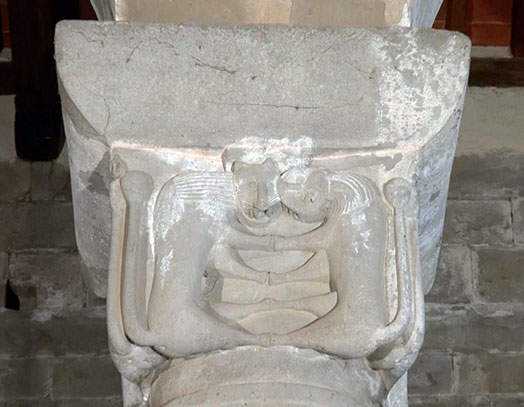THE CAPITAL of the COMBATTENT LIONS
right nave, second column
Two wild animals fighting, paw against paw, with upright tails and jaws wide open, are represented in a rampant position facing each other on each side of the capital. On the corners, instead of volutes, there are four small heads. Identified as tigers by Mons. V. Moretti (2004) and as lions by Gandolfo (2003), the latter is more probably correct: in fact all the animals have long manes and tails ending in a tassel, whereas tigers have neither manes nor tufts on their tails .
In this heraldic pose, one of the lions sinks its fangs into the head of the other. Fighting between two animals of the same species was interpreted by V. Moretti (2004) as a reference to fratricidal violence, but the lion is one of the animals that in the Romanesque period had various, often contradictory interpretations: if struggling against a creature with negative connotations (for example the ram or the dragon) it could represent Christ, who vanquishes the forces of evil, or the battle between diabolic powers to obtain the soul of a sinner, or the disorder and chaos between the negative forces themselves. This last interpretation is perhaps the one most apt for this capital, and does not exclude that of an a fratricidal struggle as well, extended to include all mankind: in other words, war.
The author of this capital was again the local stone-cutter, perhaps from the Valdarno or the area around Arezzo, who also sculpted the two following capitals, these completing the Romanesque phase of building in the pieve. The sustained violence, expressed by the arched backs and the rigid paws of beasts with long fangs, as well as the type of model followed, make this capital stylistically similar to one in the pieve of Arezzo.

